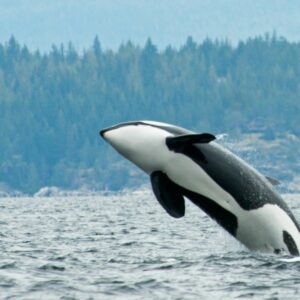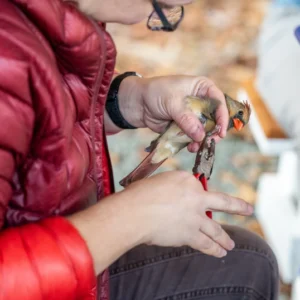Meet (and Hear) the Frogs of Canada
I live just outside Ottawa, off the beaten track, and on May and June nights I can hear my neighbours singing out enthusiastically as if they were on stage:
Peep-peep-peep, gung… gung… gung, OORAR-OORAR-HAH!
These are, of course, the inhabitants of my pond and woods, not my block: spring peepers, green frogs, and bullfrogs. That rendering of the bullfrog call I borrowed from Henry David Thoreau, the 19th-century writer, naturalist and student of frogs. A neighbour of his once remarked of Thoreau, “That darned fool had been standin’— the livelong day — a-studyin’—the habits—of the bull-frog!”
But if Henry David Thoreau were around now, Nature Canada would be standing right beside him, a-studyin’ frogs with the same keen interest. Frogs are cool… and important.
A double life
Frogs are amphibians. That word comes from the Greek “amphi” (both) and “bios” ( life). As their name implies, frogs live two lives. Once hatched from eggs, most frogs begin their existence as tadpoles, equipped with gills to breathe underwater. Later they undergo a metamorphosis, developing legs and lungs and moving onto land.
According to the Canadian Encyclopedia, we have 24 species of toads and frogs in Canada. (Toads are a kind of frog, with stubby bodies and dry, warty skin.) The most widely distributed frogs and toads in Canada are the green frog, northern leopard frog, pickerel frog, spring peeper, American bullfrog, wood frog, American toad, boreal chorus frog, mink frog and grey tree frog. They are found in all kinds of habitats, from forests to wetlands and even Arctic landscapes.
But wherever they are found, frogs are important to the ecosystem. As tadpoles, they eat algae, reducing algal blooms and filtering water. As adults, they eat flies, mosquitoes and other insect pests. They are a food source for birds, fish, raccoons, snakes and other wildlife. And they are the web-footed equivalent of canaries in the coal mine, allowing us to gauge the health of the environment around them.
The skinny on frog skin
A frog’s skin is semi-permeable, meaning that water and gasses (like oxygen and carbon dioxide) can flow through it. The skin can thus function like lungs, which is why frogs can breathe underwater.
Because of their porous skin, frogs are very sensitive to contaminants in the air and water. That’s why they are valuable as “bio-indicators,” signaling the health of the ecosystems they inhabit. When frogs start to disappear from an area, you can bet that something is awry, to use a word that Henry David Thoreau might have liked.
Helping frogs live humid, happy lives
Here are some things you can do to help Canada’s frogs:
- Build a pond on your property
- Provide piles of rocks, logs and leaves on your property; these offer places for toads and frogs to hide, forage and find shade.
- Don’t use pesticides
- Conserve wetlands near you
For more tips, see this page from the Canadian Herpetological Society.
Stay up to date with the latest in Canadian nature by subscribing to our emails. You’ll receive regular updates about what we’re doing to protect wildlife like frogs—and how you can help.



